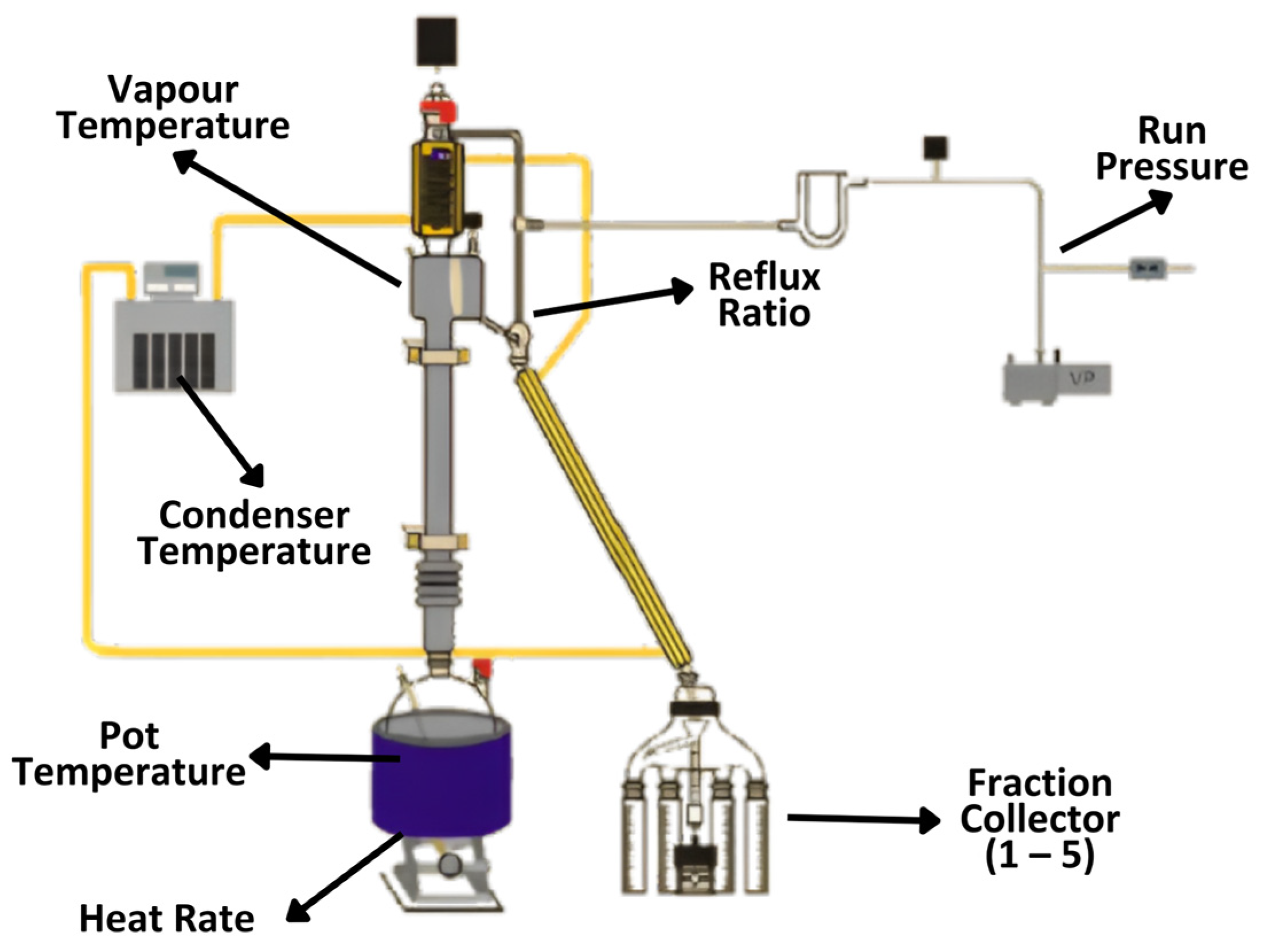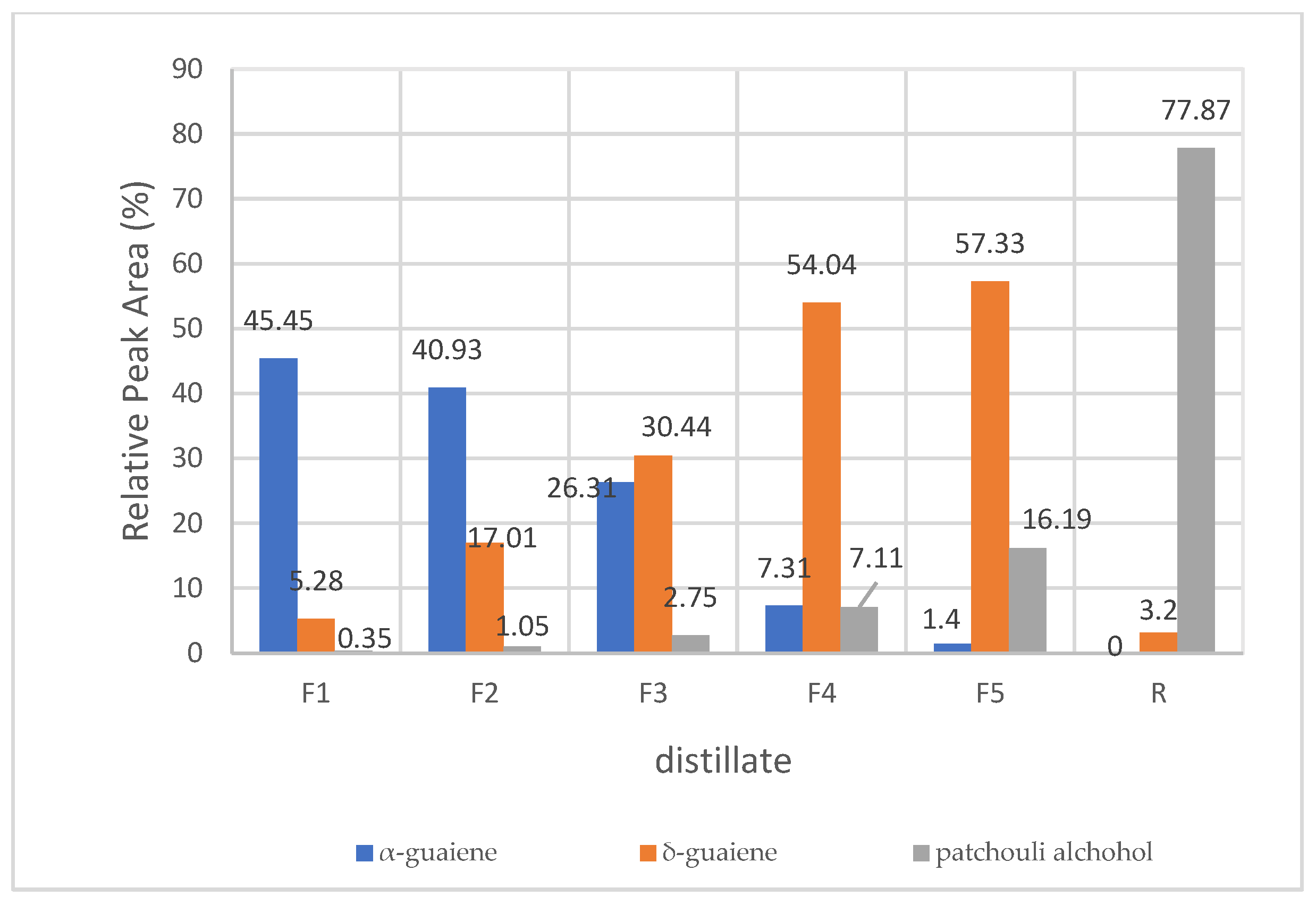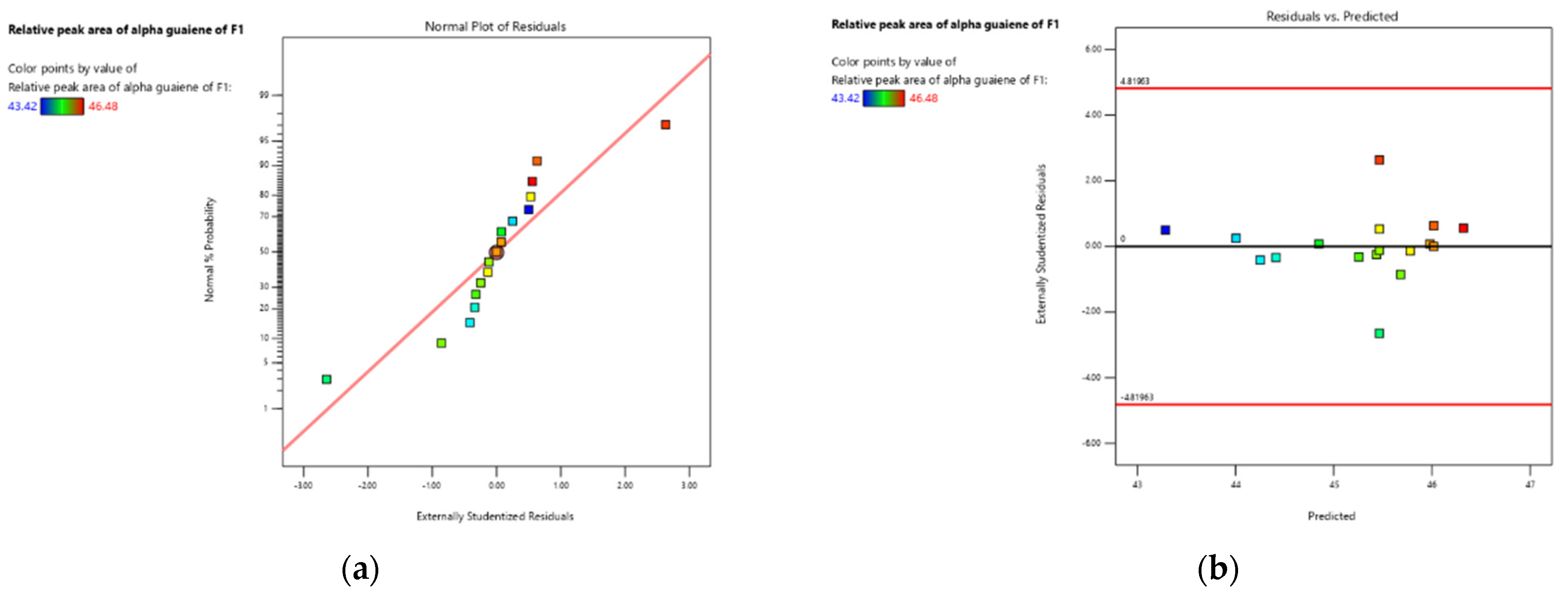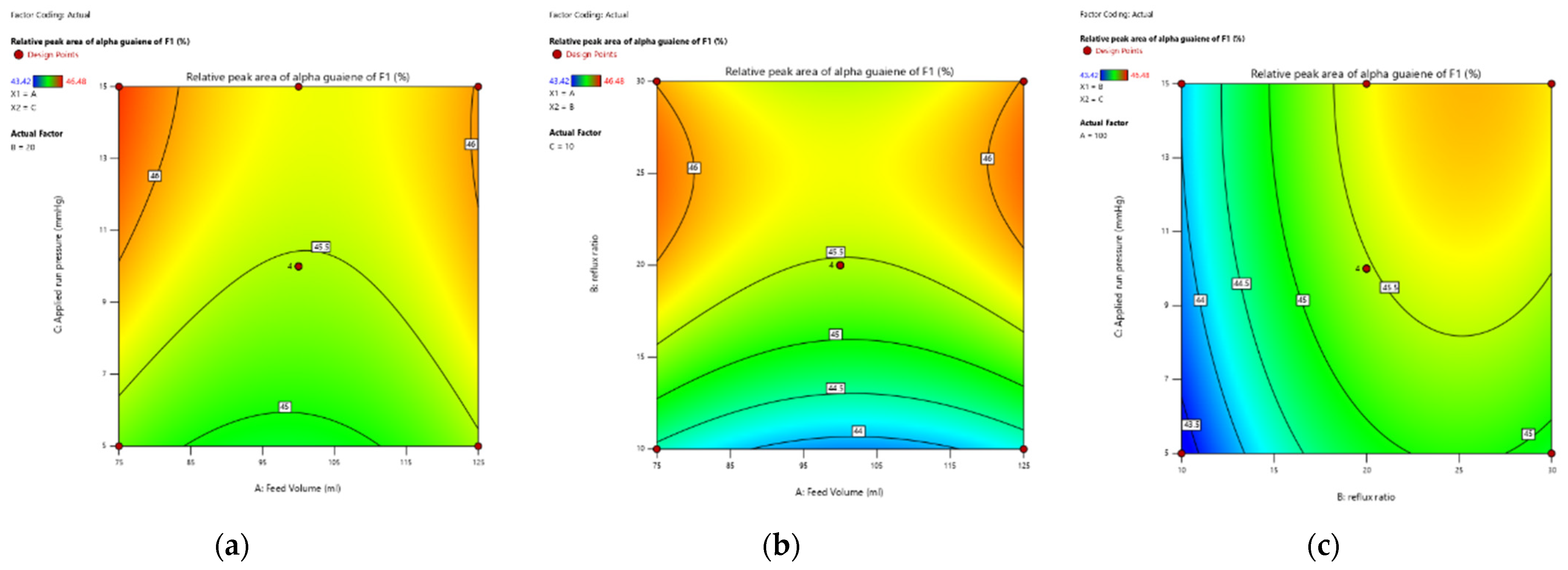Optimization of the Vacuum Fractional Distillation Process for Enhancing the α-Guaiene of Patchouli Oil with Response Surface Methodology
Abstract
:1. Introduction
2. Materials and Methods
2.1. Vacuum Fractional Distillation
2.2. Experimental Design
2.3. Gas Chromatography–Mass Spectroscopy (GC-MS) Analysis
2.4. Physicochemical Characterization of α-Guaiene Enriched Fraction
3. Results
3.1. Composition of Crude Patchouli Oil
3.2. Determination of the Presence of α-Guaiene Enriched Fraction
3.3. Analysis of Treatment and Response Optimization
3.3.1. Data Analysis, Data Processing, and Model Fitting
3.3.2. Contour Diagram
3.3.3. Determination of Optimum Point
3.3.4. Model Validation
3.4. Characteristics of α-Guaiene-Enriched Fraction
3.4.1. Yield of α-Guaiene-Enriched Fraction 1
3.4.2. Composition of Optimum-α-Guaiene-Enriched Fraction 1
3.4.3. Color of α-Guaiene-Enriched Fraction 1
3.4.4. Refractive Index and Specific Gravity of α-Guaiene-Enriched Fraction
4. Conclusions
Author Contributions
Funding
Institutional Review Board Statement
Informed Consent Statement
Data Availability Statement
Acknowledgments
Conflicts of Interest
References
- Ramya, H.G.; Palanimuthu, V.; Rachna, S. An introduction to patchouli (Pogostemon cablin Benth.)—A medicinal and aromatic plant: It’s importance to mankind. Agric. Eng. Int. CIGR J. 2013, 15, 243–250. [Google Scholar]
- Deguerry, F.; Pastore, L.; Wu, S.; Clark, A.; Chappell, J.; Schalk, M. The diverse sesquiterpene profile of patchouli, Pogostemon cablin, is correlated with a limited number of sesquiterpene synthases. Arch. Biochem. Biophys. 2006, 454, 123–136. [Google Scholar] [CrossRef]
- Das, K. Patchouli (Pogostemon Cablin Benth) Oils; Elsevier Inc.: Amsterdam, The Netherlands, 2016. [Google Scholar]
- Swamy, M.K.; Sinniah, U.R. A comprehensive review on the phytochemical constituents and pharmacological activities of Pogostemon cablin Benth.: An aromatic medicinal plant of industrial importance. Molecules 2015, 20, 8521–8547. [Google Scholar] [CrossRef] [PubMed]
- Hasegawa, T.; Yoshitome, K.; Fujihara, T.; Santoso, M.; Aziz, M.A. Characteristic changes in the aroma profile of patchouli depending on manufacturing process. J. Oleo Sci. 2017, 66, 863–869. [Google Scholar] [CrossRef]
- ISO 3757:2002; International Standard 3757 ISO Oil of Patchouli [Pogostemon cablin (Blanco) Benth.]. 2nd ed. ISO: Geneva, Switzerland, 2002.
- Hu, L.F.; Li, S.P.; Cao, H.; Liu, J.J.; Gao, J.L.; Yang, F.Q.; Wang, Y.T. GC-MS fingerprint of Pogostemon cablin in China. J. Pharm. Biomed. Anal. 2006, 42, 200–206. [Google Scholar] [CrossRef] [PubMed]
- Isfaroiny, R.; Jurusan, M.; Fmipa, K.; Negeri, U.; Kampus, S.; Surabaya, K. Peningkatan Kadar Patchouli Alcohol Pada Minyak Nilam. Berk. Penelit. Hayati 2005, 10, 123–127. [Google Scholar] [CrossRef]
- Rakotonirainy, O.; Gaydou, E.M.; Faure, R.; Bombarda, I. Sesquiterpenes from Patchouli (Pogostemon cablin) Essential Oil. Assignment of the Proton and Carbon-13 NMR Spectra. J. Essent. Oil Res. 1997, 9, 321–327. [Google Scholar] [CrossRef]
- Buré, C.M.; Sellier, N.M. Analysis of the essential oil of indonesian patchouli (Pogostemon cabin benth.) using GC/MS (EI/CI). J. Essent. Oil Res. 2004, 16, 17–19. [Google Scholar] [CrossRef]
- Anonis, D.P. Woody notes in perfumery Patchouly Oil, Absolute and Aroma Chemicals: Part I. Perfum. Flavorist Mag. 2006, 31, 3–6. [Google Scholar]
- Tsai, Y.C.; Hsu, H.C.; Yang, W.C.; Tsai, W.J.; Chen, C.C.; Watanabe, T. α-Bulnesene, a PAF inhibitor isolated from the essential oil of Pogostemon cablin. Fitoterapia 2007, 78, 7–11. [Google Scholar] [CrossRef]
- Prakash, O.; Joshi, S.; Shukla, A.K.; Pant, A.K. Sesquiterpenoid Rich Essential Oil from the Leaves of Pogostemon patchouli Pellet Grown Organically Under Tarai Conditions. J. Essent. Oil Bear. Plants 2013, 10, 157–161. [Google Scholar] [CrossRef]
- Blank, A.F.; Sant’ana, T.C.P.; Santos, P.S.; Arrigoni-Blank, M.F.; do Nascimento Prata, A.P.; Jesus, H.C.R.; Alves, P.B. Chemical characterization of the essential oil from patchouli accessions harvested over four seasons. Ind. Crops Prod. 2011, 34, 831–837. [Google Scholar] [CrossRef]
- Hussin, N.; Mondello, L.; Costa, R.; Dugo, P.; Yusoff, N.I.N.; Yarmo, M.A.; AbWahab, A.; Said, M. Quantitative and physical evaluation of patchouli essential oils obtained from different sources of Pogostemon cablin. Nat. Prod. Commun. 2012, 7, 927–930. [Google Scholar] [CrossRef]
- Aisyah, Y.; Anwar, S.H.; Annisa, Y. Effect of the Fractional Distillation on an Increment Patchouli Alcohol Content in Patchouli Oil Chemical Constituent of Patchouli. In Proceedings of the 2nd International Conference of Essential Oils (ICEO 2019), Banda Aceh, Indonesia, 29–30 October 2019; pp. 80–85. [Google Scholar] [CrossRef]
- The GoodScent Company. TGSC Information System: Alpha Guaiene. 2019. Available online: http://www.thegoodscentscompany.com/data/rw1054351.html#tosafiu (accessed on 6 October 2019).
- Huang, A.-C.; Sefton, M.A.; Taylor, D.K. Comparison of the Formation of Peppery and Woody Sesquiterpenes Derived from α-Guaiene and α-Bulnesene under Aerial Oxidative Conditions. J. Agric. Food Chem. 2015, 63, 1932–1938. [Google Scholar] [CrossRef] [PubMed]
- Huang, A.-C.; Burrett, S.; Sefton, M.A.; Taylor, D.K. Production of the pepper aroma compound, (-)-rotundone, by aerial oxidation of α-guaiene. J. Agric. Food Chem. 2014, 62, 10809–10815. [Google Scholar] [CrossRef] [PubMed]
- Huang, A.-C.; Sefton, M.A.; Sumby, C.J.; Tiekink, E.R.T.; Taylor, D.K. Mechanistic studies on the autoxidation of α-guaiene: Structural diversity of the sesquiterpenoid downstream products. J. Nat. Prod. 2015, 78, 131–145. [Google Scholar] [CrossRef]
- Anggraeni, N.D.; Nurjanah, S.; Lembong, E. Uji Aktivitas Antibakteri α-guaiene Minyak Nilam terhadap Bakteri Staphylococcus aureus DAN Staphylococcus epidermidis. Gontor Agrotech Sci. J. 2020, 6, 413–423. [Google Scholar] [CrossRef]
- Maulani, M.; Nurjanah, S.; Lembong, E. Antifungal activites of α-guaiene from Pathouli against Microsporum gypseum ATCC 14683 and Tricophyton mentagrophytes. J. Keteknikan Pertan. Trop. Dan Biosist. 2022, 10, 74–83. [Google Scholar] [CrossRef]
- Widyasanti, A.; Nurjanah, S.; Nurhadi, B.; Osman, C.P. Isolation of guaiene from crude and distillate patchouli oil extracted by molecular distillation. IOP Conf. Ser. Earth Environ. Sci. 2021, 924, 012008. [Google Scholar] [CrossRef]
- Nurjanah, S.; Rialita, T.; Lembong, E.; Muhaemin, M.; Widyasanti, A.; Sidabutar, I.; Aprima, Z.E.; Amrullah, R. Isolation of guaiene from patchouli (Pogostemon cablin Benth.) oil using vacuum fractionation distillation. IOP Conf. Ser. Earth Environ. Sci. 2020, 443, 012094. [Google Scholar] [CrossRef]
- Berk, Z.; Berk, Z. Chapter 13—Distillation. In Food Process Engineering and Technology; Elsevier: Amsterdam, The Netherlands, 2009; pp. 295–315. [Google Scholar]
- Foust, A.S.; Wenzel, L.A.; Clump, C.W.; Maus, L.; Andersen, L.B. Principles of Unit Operations; John Wiley & Sons: Hoboken, NJ, USA, 2009. [Google Scholar]
- Carley, K.M.; Kamneva, N.Y.; Reminga, J. Response Surface Methodology: CASOS Technical Report. Network 2004, 2, 128–149. [Google Scholar] [CrossRef]
- Wang, R.; Wang, R.; Yang, B. Extraction of essential oils from five cinnamon leaves and identification of their volatile compound compositions. Innov. Food Sci. Emerg. Technol. 2009, 10, 289–292. [Google Scholar] [CrossRef]
- Belhachat, D.; Mekimene, L.; Belhachat, M.; Ferradji, A.; Aid, F. Application of response surface methodology to optimize the extraction of essential oil from ripe berries of Pistacia lentiscus using ultrasonic pretreatment. J. Appl. Res. Med. Aromat. Plants 2018, 9, 132–140. [Google Scholar] [CrossRef]
- Mohamed, O.A.; Masood, S.H.; Bhowmik, J.L. Mathematical modeling and FDM process parameters optimization using response surface methodology based on Q-optimal design. Appl. Math. Model. 2016, 40, 10052–10073. [Google Scholar] [CrossRef]
- Sidabutar, I.J.; Widyasanti, A.; Nurjanah, S.; Nurhadi, B.; Rialita, T.; Lembong, E. Kajian Rasio Refluk pada Isolasi Beberapa Senyawa Minyak Nilam (Pogestemon cablin Benth) dengan Metode Destilasi Fraksinasi. J. Ilm. Rekayasa Pertan. Dan Biosist. 2020, 8, 71–78. [Google Scholar] [CrossRef]
- Engelen, A.; Sugiyono; Budijanto, S. Optimasi Proses dan Formula pada Pengolahan mi Sagu Kering. Agritech 2015, 35, 359–367. [Google Scholar] [CrossRef]
- Hutching, J.B. Food Color and Appearance, 2nd ed.; Aspen Pub.: Frederick, MD, USA, 1999; p. 1999. [Google Scholar]





| Distillation method | α-Guaiene (%) | δ-Guaiene (%) | References |
|---|---|---|---|
| Steam distillation | 21.5 | 34.6 | [9] |
| Steam distillation | 15.6 | 16.7 | [10] |
| Steam distillation | 15–21.5 | 13.0–34.6 | [11] |
| Pressurized liquid extractions | 1.66–10.23 | 0.85–12.51 | [7] |
| Steam distillation | 20.62 | 16.18 | [12] |
| Hydrodistillation | 23.3 | 21.4 | [13] |
| Hydrodistillation | 3.17–22.2 | 9.86–20.3 | [14] |
| Hydrodistillation | 3.4–9.4 | 5.2–14.4 | [15] |
| Fractional distillation | 16.61–18.10 | 20.08–21.45 | [16] |
| Variable Independent | Level | ||
|---|---|---|---|
| Low (−1) | Medium (0) | High (1) | |
| A: Feed volume (mL) | 75 | 100 | 125 |
| B: Reflux ratio | 10:1 | 20:1 | 30:1 |
| C: Applied run pressure (mmHg) | 5 | 10 | 15 |
| Run | Factor 1 A: Feed Volume (mL) | Factor 2 B: Reflux Ratio | Factor 3 C: Applied Run Pressure (mmHg) | Response Relative Peak Area α-Guaiene of Fraction 1 (%) |
|---|---|---|---|---|
| 1 | 100 | 30 | 15 | 45.74 |
| 2 | 100 | 10 | 15 | 44.08 |
| 3 | 75 | 30 | 10 | 46.00 |
| 4 | 100 | 20 | 15 | 45.31 |
| 5 | 125 | 20 | 15 | 46.20 |
| 6 | 100 | 20 | 10 | 45.71 |
| 7 | 125 | 20 | 5 | 45.37 |
| 8 | 100 | 20 | 10 | 44.62 |
| 9 | 75 | 20 | 15 | 46.48 |
| 10 | 125 | 30 | 10 | 46.02 |
| 11 | 75 | 20 | 5 | 45.17 |
| 12 | 100 | 10 | 5 | 43.42 |
| 13 | 125 | 10 | 10 | 44.14 |
| 14 | 100 | 20 | 10 | 46.31 |
| 15 | 100 | 30 | 5 | 44.87 |
| 16 | 100 | 20 | 10 | 45.41 |
| 17 | 75 | 10 | 10 | 44.32 |
| No. | RT | Relative Peak Area (%) | Chemical Compound | Molecular Formula | Molecular Weight (mol) |
|---|---|---|---|---|---|
| Sesquiterpene hydrocarbons | |||||
| 1 | 18.803 | 3.21 | β-Patchoulene | C15H24 | 204.351 |
| 2 | 22.669 | 0.69 | Cycloseychellene | C15H24 | 204.351 |
| 3 | 24.630 | 19.33 | α-Guaiene | C15H24 | 204.351 |
| 4 | 24.446 | 5.12 | α-Patchoulene | C15H24 | 204.351 |
| 5 | 26.654 | 9.49 | Seychellene | C15H24 | 204.351 |
| 6 | 27.453 | 0.98 | Patchoulene | C15H24 | 204.351 |
| 7 | 28.413 | 0.52 | Humulene | C15H24 | 204.351 |
| 8 | 28.631 | 0.65 | Germacrene-b | C15H24 | 204.351 |
| 9 | 30.364 | 2.74 | Aciphyllene | C15H24 | 204.351 |
| 10 | 31.116 | 19.25 | δ-Guaiene | C15H24 | 204.351 |
| 11 | 33.243 | 0.6 | β-Gurjurene | C15H24 | 204.351 |
| 12 | 48.555 | 0.32 | Isolongifolene,9,10-dehydro | C15H22 | 202.330 |
| 13 | 49.084 | 0.84 | Aciphyllene | C15H24 | 204.351 |
| 14 | 49.473 | 0.21 | trans-Caryophyllene | C15H24 | 204.351 |
| 15 | 49.738 | 0.28 | 1,8-dimethyl-5-propane-2-ylidenetricyclo [5.3.0.04,8] decane | C15H24 | 204.351 |
| Oxygenated hydrocarbon | |||||
| 16 | 48.379 | 0.69 | Norpatchoulenol | C14H22O | 206.320 |
| 17 | 49.359 | 32.04 | Patchouli alcohol | C15H26O | 222.000 |
| 18 | 49.530 | 0.55 | Germacra-4(15),5,10(14)-trien-1β-ol | C15H24O | 220.351 |
| 19 | 49.821 | 2.27 | Pogostol | C15H26O | 222.366 |
| 20 | 50.594 | 0.23 | Rotundone | C15H22O | 218.335 |
| Source | Sum of Squares | df | Mean Square | F-Value | p-Value | |
|---|---|---|---|---|---|---|
| Model | 10.81 | 9 | 1.20 | 4.82 | 0.0251 | significant |
| A-feed volume | 0.0072 | 1 | 0.0072 | 0.0289 | 0.8699 | non-significant |
| B-reflux ratio | 5.56 | 1 | 5.56 | 22.31 | 0.0021 | significant |
| C-applied run pressure | 1.5 | 1 | 1.5 | 6.00 | 0.0441 | significant |
| AB | 0.0100 | 1 | 0.0100 | 0.0401 | 0.8469 | non-significant |
| AC | 0.0576 | 1 | 0.0576 | 0.2311 | 0.6454 | non-significant |
| BC | 0.0110 | 1 | 0.0110 | 0.0442 | 0.8394 | non-significant |
| A2 | 1.00 | 1 | 1.00 | 4.02 | 0.0850 | non-significant |
| B2 | 2.61 | 1 | 2.61 | 10.45 | 0.0144 | significant |
| C2 | 0.1618 | 1 | 0.1618 | 0.6490 | 0.4470 | non-significant |
| Residual | 1.74 | 7 | 0.2493 | |||
| Lack of Fit | 0.2627 | 4 | 0.0657 | 0.1329 | 0.9597 | non-significant |
| Pure Error | 1.48 | 3 | 0.4940 | |||
| Cor Total | 12.55 | 16 |
| Parameter | Value |
|---|---|
| Std. Dev. | 0.4993 |
| Mean | 45.25 |
| C.V. % | 1.10 |
| R2 | 0.8610 |
| Adjusted R2 | 0.6823 |
| Predicted R2 | 0.6523 |
| Adequate Precision | 7.9217 |
| Factor | Coefficient Estimate | df | Standard Error | 95% CI Low | 95% CI High | VIF |
|---|---|---|---|---|---|---|
| Intercept | 45.47 | 1 | 0.2439 | 44.89 | 46.04 | |
| A-feed volume | −0.0300 | 1 | 0.1765 | −0.4474 | 0.3874 | 10.00 |
| B-reflux ratio | 0.8338 | 1 | 0.1765 | 0.4164 | 1.25 | 10.00 |
| C-applied run pressure | 0.4123 | 1 | 0.1683 | 0.0143 | 0.8102 | 1.02 |
| AB | 0.0500 | 1 | 0.2496 | −0.5403 | 0.6403 | 10.00 |
| AC | −0.1200 | 1 | 0.2496 | −0.7103 | 0.4703 | 10.00 |
| BC | 0.0525 | 1 | 0.2496 | −0.5378 | 0.6428 | 10.00 |
| A2 | 0.4890 | 1 | 0.2439 | −0.0877 | 1.07 | 1.01 |
| B2 | −0.7885 | 1 | 0.2439 | −1.37 | −0.2118 | 1.01 |
| C2 | −0.1965 | 1 | 0.2439 | −0.7732 | 0.3802 | 1.01 |
| Component Variable and Response | Target | Lower Limit | Upper Limit | Importance |
|---|---|---|---|---|
| Feed volume (mL) | In range | 75 | 125 | 3 |
| Reflux ratio | In range | 10 | 30 | 3 |
| Applied run pressure (mmHg) | In range | 5 | 15 | 3 |
| Relative peak area of α-guaiene of fraction 1 (%) | Maximize | 43.42 | 46.48 | 5 |
| No | Feed Volume | Reflux Ratio | Applied Run Pressure | α-Guaiene of F1 | Desirability | |
|---|---|---|---|---|---|---|
| 1 | 75.468 | 23.618 | 14.803 | 46.493 | 1.000 | Selected |
| 2 | 75.493 | 23.527 | 14.939 | 46.494 | 1.000 | |
| 3 | 75.754 | 26.368 | 14.587 | 46.486 | 1.000 | |
| .. | .. | .. | .. | .. | .. | |
| 79 | 75.297 | 25.482 | 13.923 | 46.484 | 1.000 | |
| Response | Predicted | Actual | 95% CI Low for Mean | 95% CI High for Mean | Std. Deviation | Validation (%) |
|---|---|---|---|---|---|---|
| Relative peak area of α-guaiene of fraction 1(%) | 46.49 | 44.47 | 43.39 | 49.59 | 0.49 | 96.14 |
| Run | Feed Volume | Reflux Ratio | Applied Run Pressure | Yield α-Guaiene-Enriched Fraction 1 (% Mass) |
|---|---|---|---|---|
| 1 | 100 | 30 | 15 | 10.3 |
| 2 | 100 | 10 | 15 | 10.84 |
| 3 | 75 | 30 | 10 | 16.6 |
| 4 | 100 | 20 | 10 | 14.13 |
| 5 | 125 | 20 | 15 | 8.98 |
| 6 | 100 | 20 | 10 | 20.16 |
| 7 | 125 | 20 | 5 | 10.15 |
| 8 | 100 | 20 | 10 | 9.19 |
| 9 | 75 | 20 | 15 | 14.72 |
| 10 | 125 | 30 | 10 | 14.54 |
| 11 | 75 | 20 | 5 | 10.45 |
| 12 | 100 | 10 | 5 | 5.61 |
| 13 | 125 | 10 | 10 | 14.43 |
| 14 | 100 | 20 | 10 | 18.09 |
| 15 | 100 | 30 | 5 | 8.58 |
| 16 | 100 | 20 | 10 | 11.85 |
| 17 | 75 | 10 | 10 | 8.14 |
| Optimum α-guaiene | 75 | 24 | 14.8 | 15.92 |
| SI No. | RT | Area (%) | Chemical Compound | Molecular Formula | Molecular Weight (mol) |
|---|---|---|---|---|---|
| Sesquiterpene hydrocarbons | |||||
| 1 | 17.776 | 0.33 | δ-Elemene | C15H24 | 204.351 |
| 2 | 18.227 | 11.98 | β-Patchoulene | C15H24 | 204.351 |
| 3 | 19.078 | 0.18 | 18-Norabieta-8,11,13-triene | C19H28 | 256.425 |
| 4 | 20.858 | 0.17 | 3,5,11-Eudesmatriene | C15H22 | 202.335 |
| 5 | 21.984 | 2.36 | Cycloseycellene | C15H24 | 204.351 |
| 6 | 22.996 | 0.21 | Cycloisolongifolene | C15H24 | 204.351 |
| 7 | 23.369 | 0.22 | β-Elemene | C15H24 | 204.351 |
| 8 | 21.127 | 44.47 | α-Guaiene | C15H24 | 204.351 |
| 9 | 25.813 | 7.54 | α-Patchoulene | C15H24 | 204.351 |
| 10 | 26.052 | 15.54 | Seychellene | C15H24 | 204.351 |
| 11 | 26.493 | 0.14 | γ-Elemene | C15H24 | 204.351 |
| 12 | 26.783 | 1.49 | Patchoulene | C15H24 | 204.351 |
| 13 | 27.416 | 0.13 | α-Selinene | C15H24 | 204.351 |
| 14 | 27.738 | 0.76 | Humulene | C15H24 | 204.351 |
| 15 | 27.945 | 0.37 | 1H-Benzocycloheptene | C15H24 | 204.351 |
| 16 | 28.018 | 0.22 | Caryophyllene | C15H24 | 204.351 |
| 17 | 29.237 | 0.36 | aR-Himachalene | C15H22 | 202.330 |
| 18 | 29.663 | 1.49 | Aciphyllene | C15H24 | 204.351 |
| 19 | 29.824 | 2.50 | γ-Gurjunene | C15H24 | 204.351 |
| 20 | 30.395 | 8.27 | δ-Guaiene | C15H24 | 204.351 |
| 21 | 48.518 | 0.06 | Aristolediene | C15H22 | 202.330 |
| 22 | 48.684 | 0.05 | Silphiperfola-4,7(14)-diene | C15H22 | 202.330 |
| 23 | 48.830 | 0.05 | Aromadendrene, dehydro | C15H24 | 204.351 |
| 24 | 49.509 | 0.08 | Solavetivone | C15H22 | 202.330 |
| 25 | 49.670 | 0.05 | δ-Guaiene | C15H24 | 204.351 |
| Oxygenated hydrocarbons | |||||
| 26 | 43.387 | 0.24 | Caryophyllene oxide | C15H24O | 220.350 |
| 27 | 48.223 | 0.10 | β-Caryophyllene oxide | C14H22O | 206.320 |
| 28 | 49.157 | 0.57 | Patchouli alchohol | C15H26O | 222.000 |
| Miscellaneous | |||||
| 29 | 49.899 | 0.06 | 2-[1-(4-Methoxy-phenyl)-1H-tetrazol-5-ylsulfanylmethyl]-1H-benzoimidazole | C16H14N6OS | 308.370 |
| Run | Color Parameters | Chromaticity | ||||||
|---|---|---|---|---|---|---|---|---|
| L * | a * | b * | C | H | Refractive Index | Specific Gravity | ||
| 1 | 7.61 | −0.85 | 3.09 | 3.20 | 105.31 | 1.501 | 0.925 | Yellow |
| 2 | 5.46 | −0.83 | 3.45 | 3.55 | 103.46 | 1.499 | 0.926 | Yellow |
| 3 | 14.24 | −2.53 | 13.38 | 13.62 | 100.73 | 1.498 | 0.930 | Yellow |
| 4 | 17.97 | −2.37 | 16.03 | 16.20 | 98.41 | 1.498 | 0.925 | Yellow |
| 5 | 14.50 | −2.10 | 14.51 | 14.66 | 98.25 | 1.498 | 0.921 | Yellow |
| 6 | 12.95 | −1.30 | 13.90 | 13.96 | 95.34 | 1.499 | 0.921 | Yellow |
| 7 | 13.20 | −2.16 | 14.49 | 14.65 | 98.47 | 1.498 | 0.919 | Yellow |
| 8 | 9.86 | −1.00 | 6.53 | 6.61 | 98.69 | 1.499 | 0.917 | Yellow |
| 9 | 9.26 | −1.42 | 8.64 | 8.75 | 99.36 | 1.498 | 0.913 | Yellow |
| 10 | 14.61 | −1.86 | 16.08 | 16.19 | 96.59 | 1.499 | 0.903 | Yellow |
| 11 | 11.82 | −2.21 | 11.17 | 11.38 | 101.17 | 1.498 | 0,920 | Yellow |
| 12 | 4.42 | −1.23 | 3.67 | 3.87 | 108.44 | 1.498 | 0.919 | Yellow |
| 13 | 14.41 | −2.07 | 13.93 | 14.09 | 98.46 | 1.499 | 0.920 | Yellow |
| 14 | 12.18 | −1.30 | 11.81 | 11.89 | 96.28 | 1.499 | 0.923 | Yellow |
| 15 | 10.38 | −1.98 | 9.27 | 9.48 | 102.07 | 1.498 | 0.920 | Yellow |
| 16 | 11.11 | −1.96 | 10.76 | 10.94 | 100.28 | 1.499 | 0.920 | Yellow |
| 17 | 8.42 | −1.82 | 6.97 | 7.20 | 104.65 | 1.498 | 0.919 | Yellow |
| Crude PO | 2.90 | 4.10 | 2.79 | 4.96 | 34.21 | 1.506 | 0.974 | Red |
| Optimum α-guaiene | 8.46 | −1.06 | 4.35 | 4.44 | 103.70 | 1.499 | 0.918 | Yellow |
Disclaimer/Publisher’s Note: The statements, opinions and data contained in all publications are solely those of the individual author(s) and contributor(s) and not of MDPI and/or the editor(s). MDPI and/or the editor(s) disclaim responsibility for any injury to people or property resulting from any ideas, methods, instructions or products referred to in the content. |
© 2023 by the authors. Licensee MDPI, Basel, Switzerland. This article is an open access article distributed under the terms and conditions of the Creative Commons Attribution (CC BY) license (https://creativecommons.org/licenses/by/4.0/).
Share and Cite
Widyasanti, A.; Nurjanah, S.; Nurhadi, B.; Osman, C.P. Optimization of the Vacuum Fractional Distillation Process for Enhancing the α-Guaiene of Patchouli Oil with Response Surface Methodology. Separations 2023, 10, 469. https://doi.org/10.3390/separations10090469
Widyasanti A, Nurjanah S, Nurhadi B, Osman CP. Optimization of the Vacuum Fractional Distillation Process for Enhancing the α-Guaiene of Patchouli Oil with Response Surface Methodology. Separations. 2023; 10(9):469. https://doi.org/10.3390/separations10090469
Chicago/Turabian StyleWidyasanti, Asri, Sarifah Nurjanah, Bambang Nurhadi, and Che Puteh Osman. 2023. "Optimization of the Vacuum Fractional Distillation Process for Enhancing the α-Guaiene of Patchouli Oil with Response Surface Methodology" Separations 10, no. 9: 469. https://doi.org/10.3390/separations10090469







